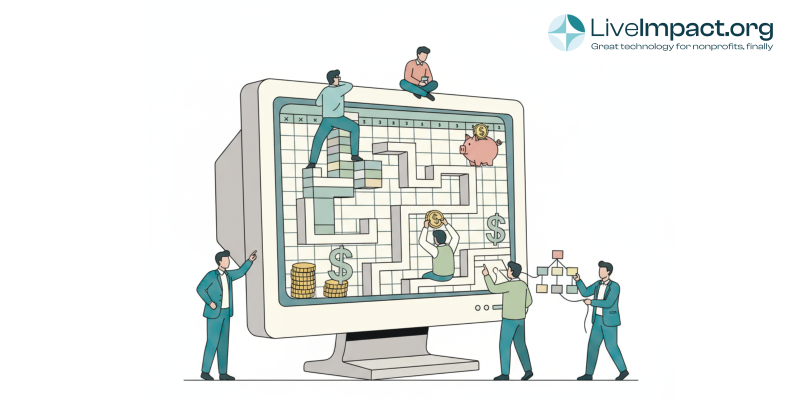Excel vs Case Management Software: Why Spreadsheets Are Costing Your Nonprofit More Than You Think
In my five years working in nonprofit case management programs, I’ve seen a common pattern: spreadsheets start out as an easy ‘budget-friendly’ solution to manage your clients and programs, but over time they begin to drag everything down. Tracking client data or program information in Excel works well enough at first and might even seem efficient. But as programs grow, reporting requirements multiply, and more staff get involved, those spreadsheets reveal their true cost.
Errors start to creep in. Staff waste hours reconciling different versions, duplicate records and missing information. Leadership ends up frustrated that reports are late, inconsistent, or incomplete, and often needs to get involved themselves. I’ve seen entire weeks lost to cleaning up data before a grant deadline, only to discover that critical data was completely missing altogether.
The irony is that nonprofits lean on spreadsheets because they look inexpensive. But when you factor in lost time, staff burnout, and missed opportunities, spreadsheets are actually one of the most expensive tools you can use. The smarter investment? A case management system that’s actually built to handle the complexity of nonprofit case management work.
Hidden Costs of Excel vs Case Management Software
Spreadsheets don’t carry a large price tag, but they do drain resources you might not notice every single day. Staff time spent reconciling different versions, re-entering data, or double-checking everything adds up quickly.
I’ve seen teams lose dozens of hours each month to tasks that could be instantaneous (or even automated) with the right system. That’s time they could have spent with clients, building partnerships, or developing new programs. Staff time is extremely valuable, and a very limited resource for small nonprofit teams. From an organizational perspective, you’re losing money on staff wages AND on the opportunity cost: the things those staff members could have been working on instead to advance the organization’s mission. When you add the cost of staff time, spreadsheets show their true form of being far more expensive than case management software.
There’s also the cost of mistakes. Even small, seemingly innocuous mistakes can be costly to nonprofits. A misplaced decimal or overwritten formula might seem minor until it impacts a report to a funder. These errors can damage trust, put funding at risk, and force staff into crisis mode trying to rebuild confidence. One lost grant due to such an error immediately makes the cost of case management software, normally a few hundred dollars a month, seem insignificant in comparison.
One Platform, One Source of Truth
Case management software gives nonprofits something spreadsheets never will: a single, reliable source of truth for your programs. With everything housed in one system, staff don’t have to piece together data from different tabs, files and cells. They know the information they’re looking at is current and accurate.
This eliminates the endless version control problems that come with spreadsheets. No more “final_v3_reallythistime.xlsx” floating around on someone else’s computer. No more uncertainty about whether a number came from last year’s programs or last week’s. Everyone works from the same, up-to-date data.
The payoff is immediate: reporting gets exponentially faster, decisions get sharper, and teams finally feel confident that they’re seeing the full picture of their case management programs.
Case Management Software is Built for Compliance and Growth
Spreadsheets weren’t designed for compliance, audit trails, or scaling across multiple programs. They might get you through the first year of a new initiative, but they fall apart as soon as requirements increase.
Case management software, on the other hand, is built with these needs in mind. Role-based permissions protect sensitive data. Audit logs make it easy to track who changed what and when. Automated workflows reduce errors by guiding staff through consistent processes.
Most importantly, a strong system grows along with your organization. Adding new programs, expanding reporting, or tracking new outcomes doesn’t mean reinventing your spreadsheets, it just means updating your system.
Reframing Costs Into Savings
When you move from spreadsheets to case management software, you stop paying hidden costs and start unlocking savings:
- Staff time is freed up for mission-focused work instead of data cleanup.
- Reporting goes from days of reconciling to minutes of generating.
- Errors are reduced with automation, saving the cost of mistakes.
- Funding opportunities increase when you can demonstrate accurate, timely impact.
- What looks like a bigger upfront investment is actually the most affordable option in the long run.
Final Thoughts
When analyzing excel vs case management software, spreadsheets may feel familiar and easy, but they so often come at the cost of efficiency, accuracy, and growth. Case management software transforms data from a long-term liability into an asset. The right case management software equips your nonprofit with the right tools to serve your community without hidden costs dragging you down.
Your time is too valuable, your staff too committed, and your mission too important to waste on spreadsheet struggles. The real question isn’t whether you can afford case management software, it’s whether you can afford not to have it.


